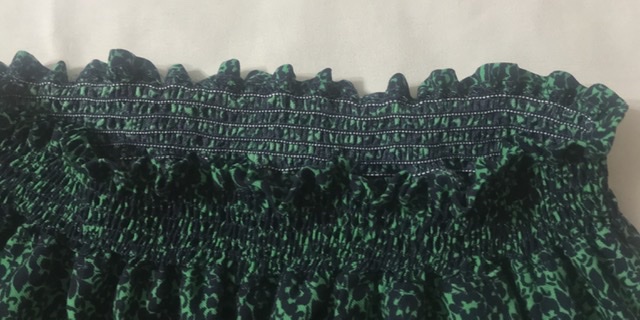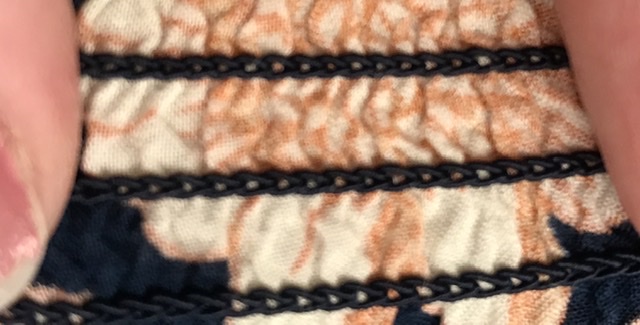Here in Florida, mid-January, I’m still wearing shorts most days, and I love it. No complaining from me! I am really liking rayon shorts with stretchy waistbands lately, which makes shirring a fun option.
I’ve done shirring with my sewing machine (see post), but this time I used the chainstitch on my serger. It works so well! Not all sergers are capable of making a chain stitch, but if yours can, you should be able to achieve similar results.

My serger is from the early ’90s, and I have a great workbook for it. In it are all kinds of useful and decorative techniques including shirring. Even though the chainstitch is used, the result does not look like the classic chainstitch on the underside. The elastic looper thread stays straight and the needle thread loops around it. It is not bulky and very stretchy. I did try different settings to achieve the normal chainstitch look, but it was bulky and not as stretchy.

I’m always observing my store bought clothes and wondered why store bought clothes with shirring do have a chainstitch look on the underside. Zooming in to look closer at the stitching, it became obvious the chainstitching on my store bought shirt is different than a serger chainstitch. It isn’t bulky and it looks like an embroidery chainstitch.

I did some research to understand why. A serger, and coverstitch too, makes a chainstitch with two threads, but store bought items are made with a single thread chainstitch. I found this video below which illustrates how a single thread chainstitch machine works. It would be amazing to have an affordable home machine capable of this, but shirring with the serger chainstitch is a great substitute.
The settings for shirring are roughly the same for basic chainstitching, with differential kept at one and a stitch length of three. Both needle and looper tensions may need to be lowered, though, to achieve the best results.
After the first row, stretch the fabric flat as additional rows are sewn. I found it helpful to use scrap fabric at the end of each row so that fabric is always under the foot. The needle thread broke every time I did not do this. Once all rows are sewn, give the shirring a good steam.
I played a little with my coverstitch, but haven’t been able to replicate the results. I’ll keep trying every once in a while.

I had no idea my serger could do that! Thx for sharing. I’m having a nostalgic remembrance from the 1970’s of a long-gone favorite slinky polyester dress with elasticized long sleeves and scoop neck, and a shirred midriff. It will be interesting to hear how others use shirring…
😁 Sounds like a lovely dress! I’ve only used shirring for waistbands, so I’d love some ideas from others too.
Hi Valerie:
I love all your videos. I just discovered them, I’ve been out of sewing for awhile. I have the Elna DC5
serger and have never been able to get the chain stitch to work right. I’ve watched your threading videos, read the manuals, changed the needle and rethreaded several times. My 3 thread looks great and the chain stitch looks terrible.., the bottom is a loopy mess..and then the thread breaks. Do you have any ideas why this is happening.. Please let me know if you have a solution.
Thank you
Thank you so much, Beverly! I’m glad you’re enjoying my videos. 😊 it’s hard to say about the chainstitch. Mine likes a little less needle tension. If you’ve played around with the tensions and it’s not helping, it might be good to take it in to be serviced. It could be a tension or maybe even a timing issue. I’m sorry I can’t be of more help!
I’ve been trying to do shirring with a cover stitch. It works well but I find the elastic doesn’t pull through evenly. It starts well, but then loses tension in the middle of the stitch and then picks back up again. How can I get it to be more even? I have tried all sorts of tension changes, skipping some steps in the elastic threading, one or two nets for the elastic fabric, etc. Any tips would be so helpful!
I’m working on shirring with a chainstitch. Overall its going well, but the tension changes as I sew. It goes from tight, to loose, and then tight again, and so on. How can I get it to thread evenly? I’ve tried one net/two nets, tension changes, bypassing certain parts of the elastic looper. Any other ideas?
Hi Alana, I haven’t had as much success with the coverstitch chain stitch either. I’m not sure what the difference is! It’s something I want to play with more to see if I can get it right, but haven’t had the time to do that yet. If I do, I will post about it! 😊